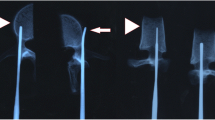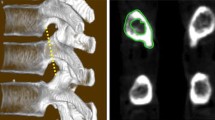Abstract.
There is no consensus over whether screw fixation for anterior cervical plating should include the posterior cortical shell of the vertebral bodies or not. Thus, the purpose of this study was to investigate the function of the posterior cortical shell with respect to maximal screw torque and pullout force. Twenty-four fresh frozen human cervical vertebrae coming from six spinal segments C4–C7 were used. They were scanned for bone mineral density (BMD) and then assigned to two groups with comparable bone density and segmental distribution. The posterior longitudinal ligament was resected carefully and two parallel burr holes were drilled into each vertebral body. The posterior cortical shell was removed in one burr hole, using a 6-mm steel burr, producing a shallow excavation with a depth of approximately 2 mm. An ABC screw was inserted into each burr hole. The screw to be inserted into the hole with the posterior excavation was called "monocortical". In contrast, the contralateral screw was called "bicortical". Peak torque was measured in one group, while pullout force was analyzed using the specimens of the second group. Mean value and standard deviation were calculated for peak torque and pullout force with respect to the type of fixation. A paired t-test was used to determine the effect of fixation type on peak torque and pullout force. Pearson moment correlation coefficients were calculated to determine the effect of BMD on peak torque and pullout force with respect to whether the screw was "mono- or bicortical". A 95% level of significance was used for all tests. No significant differences for peak torque and pullout force could be found comparing monocortical and bicortical screw fixation. However, for both monocortical and bicortical screw fixation, a positive correlation was seen for peak torque versus BMD and for pullout force versus bone mineral density, respectively. The importance of the posterior cortical shell for screw pullout force and screw peak torque seems to be negligible. In constrast, BMD greatly influences both peak torque and pullout force for both types of fixation.
Similar content being viewed by others
Author information
Authors and Affiliations
Additional information
Electronic Publication
Rights and permissions
About this article
Cite this article
Pitzen, .T., Barbier, .D., Tintinger, .F. et al. Screw fixation to the posterior cortical shell does not influence peak torque and pullout in anterior cervical plating. Eur Spine J 11, 494–499 (2002). https://doi.org/10.1007/s00586-002-0447-1
Received:
Revised:
Accepted:
Issue Date:
DOI: https://doi.org/10.1007/s00586-002-0447-1




